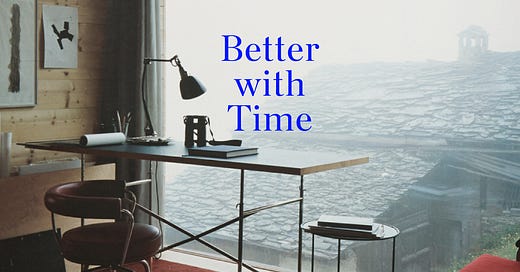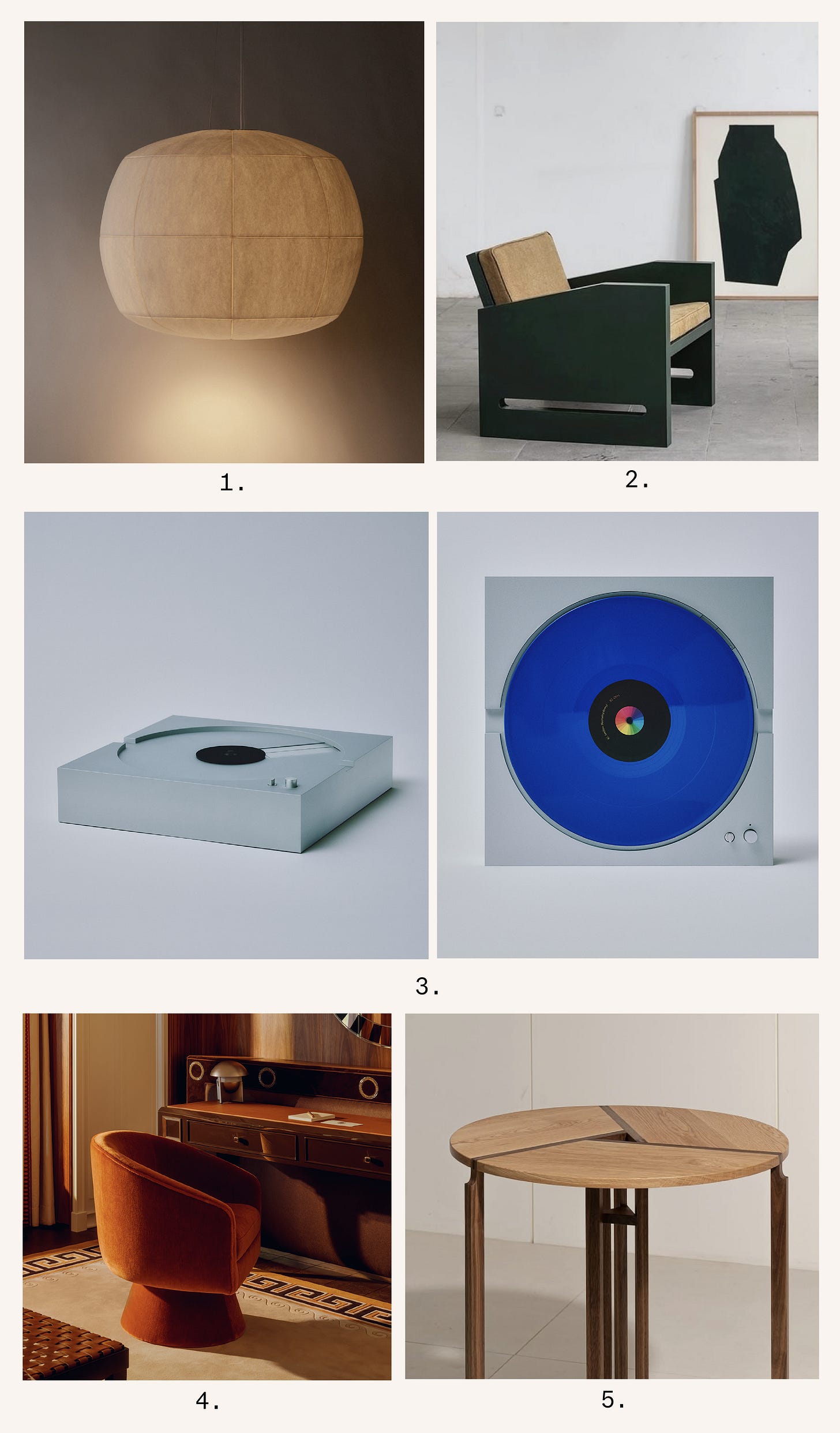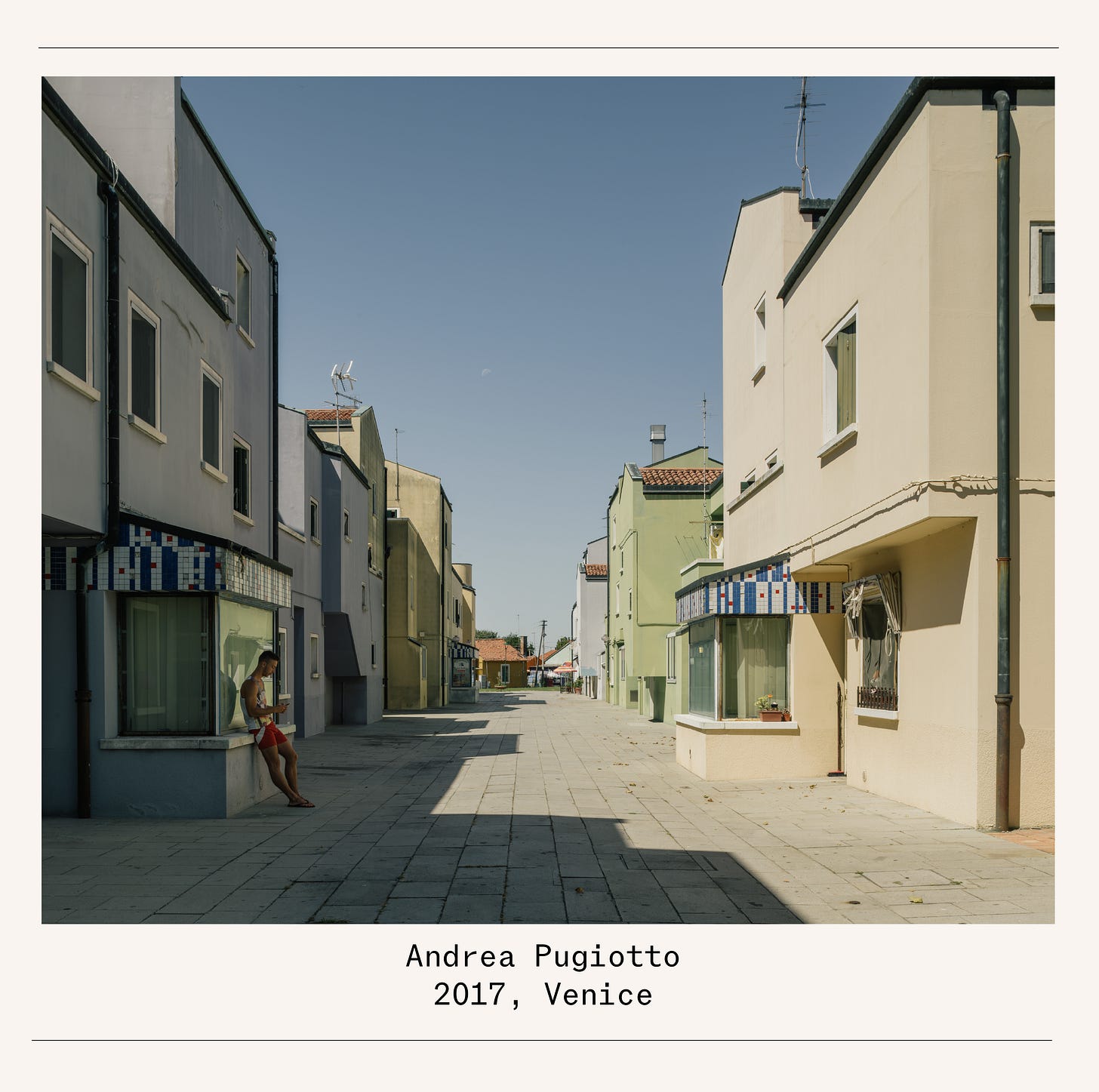Design Considered #25 – Monthly Edition
Timeless Swiss design, Paris in fine form and a left-behind island in Venice...
#01 - Opening Thought
Switzerland’s culture, deeply tied to precision, simplicity, and reverence for what nature provides, informs a distinctive approach to design exemplified by architect Peter Zumthor. Key moments in his career are documented in the recently updated five-volume monograph Peter Zumthor 1985–2013: Buildings and Projects by Park Books.
I’m encouraged (and encourage you) to spend time with these tomes, which highlight Zumthor’s patient and precise architectural approach. This is demonstrated in his Leis Houses (pictured), pared-back retreats in Vals, Switzerland (near his world-famous stone Therme Vals). In the Leis Houses, Zumthor’s refined take on Alpine construction employs locally sourced materials that gracefully age and deepen in character over time. The homes’ clean lines and natural integration with the mountainous terrain illustrate the best and most honest kind of design, imbued with an enthusiastic care for clarity.
#02 - Somewhere to Sit Down
It could be something to do with getting older; maybe I'm just getting boring, but as someone who spends a lot of time considering the design world, I find myself increasingly favouring function over form.
Over the past month, I've absorbed plenty of good design, notably in the impeccably curated halls of Paris's Matter & Shape fair. Yet here, my eye kept drifting away from what's conventionally beautiful and gravitating towards things that simply work, beautifully. Sure, this collectable design trade fair offered plenty of pretty objects, but the clean layout and thoughtfully planned public spaces were my favourite parts. Room to sit down and talk productively with vendors and contacts is rare at these industry jamborees (ironic as often what tends to be sold here are chairs). But at Matter & Shape, generous public spaces were placed across a tight and orderly floor plan. I liked it a lot. Navigating the disorganisation of the forthcoming Milan Design Week (with too many chairs to see, yet nowhere to sit in sight) worries me.
I spend a fair bit of time on Switzerland's rarely-ever-a-second-late SBB trains and marvel at their functional design details. Writing this from a spotless, perfectly temperature-controlled cabin, the sudden alpine sun blinds me - but of course, there's a handsome, hardy blind that I can lower with satisfying precision, blocking the glare yet preserving my view of the mountains. On most nations' public transit systems, the wisest option is not to touch anything with bare hands, but here, well-thought-through tactile and functional elements empower users to enjoy their journeys.
Perhaps I'm not alone in my newfound prioritisation of function and control in the things surrounding me. History demonstrates that people seek comfort through purposeful simplicity in times of uncertainty. During the Great Depression, ‘Streamline Moderne’ emerged, a movement favouring durable, unfussy furniture over ornate excess. Minimalism flourished after the 2008 financial crash; high-function, low-cost ‘tiny homes’ were suddenly appealing, and gaudy McMansions lost their shine. Today, as global uncertainties swirl, I guess there’s a reason why I’m sourcing solace in adjustable window blinds and well-ordered trade fairs.
#03 - Design Selection
Design debut season is here, and the inevitable deluge of new product press releases from Milan and beyond is about to fill your inbox. Skip the noise—below is a tight edit of five recent releases worthy of your time, attention, and a place in your home.
(1) Big Glow is a big beauty of a lighting solution, developed as an initiative from The Woolmark Company by Dutch outfit Studio Truly Truly and manufacturer Rakumba. Made in the Aussie state of Victoria with Victorian wool and plant-derived fibre, the soft glow and sumptuous form command attention, whilst clients can be assured it comes from a properly sustainable mindset. Blending Bauhaus inspiration with a Belgian sense of sophisticated elegance, Bob Verhelst’s (2) Fred armchair debuted at last year’s Salone del Mobile is now available to order from Serax in six tasteful colour combinations.
The most refined made-to-order music player on the market comes courtesy of Waiting For Ideas, a Paris-based creative studio founded in 2021 by Jean-Baptiste Anotin. (3) Turntable PP-1, available with an equally sleek pair of speakers, is a minimalist marvel: a monolithic aluminium block designed to restore intentionality to music listening. It is sharply designed and packs a significant technical punch. Staying in France, elegant lines and exceptional craftsmanship define the new (4) Contrepoint collection designed by Maxime d'Angeac. Reinterpreting Art Deco sensibilities through a contemporary lens, this chair’s refined silhouette and luxurious materials speak to a quiet sophistication, brought to life by France’s finest ateliers and available bespoke on request. Finally, the (5) Loggia Tea Table from South Korea’s Artizac pairs strength with subtlety. Crafted from solid natural materials, its clean lines and thoughtful proportions bring a quietly confident aesthetic to contemporary interiors.
#04 - For Your Consideration
Continuing this newsletter’s theme of design for longevity, legendary German luggage makers Rimowa have just announced plans to offer refurbished suitcases to the US market. Building on success in Europe and Japan, Rimowa’s Re-Crafted program sells revitalised but nicely patinaed vintage pieces, the most prized ones featuring pre-LVMH-era logos.
Another bulky yet streamlined (although slightly bigger) design, Sweden’s VÅGA Water Tower by White Arkitekter, is an assured contemporary take on brutalism. The new project proves that robust concrete forms still resonate—provided they’re designed for context, crafted with restraint, and placed sensitively within the landscape.
Pioneering Swiss architecture firm Herzog & de Meuron took to the streets—stylishly— last week, launching their latest monograph, Arquitectura Viva Monografías. Herzog & de Meuron 2017–2024, from the back of a vintage three-wheeler. Rolling between their Basel offices at Rheinschanze and Aeschenplatz, the cool mobile kiosk offered staff an exclusive first look at the book, which takes deep dives into 34 standout projects from the past 7 years.
Well before 2017, Herzog & de Meuron were involved in one of architecture's greatest refurbishments—transforming a former London power station into the Tate Modern. Ahead of the building’s quarter-centenary, an article in The Guardian revisits a remarkable chapter of creativity and cultural wonder in a landmark structure that reshaped the city.
The refurbishment of a more refined historic building than a bulky industrial behemouth comes vividly to life in Michael Kimmelman’s brilliant review of the soon-to-reopen Frick in The New York Times. Set in Henry Clay Frick’s 1914 Fifth Avenue mansion, The Frick Collection returns next month with a skillful expansion—led by architect Annabelle Selldorf of New York-based Selldorf Architects.
#05 - Through The Lens
Between jetting worldwide for editorial and commercial shoots, Venice-based photographer Andrea Pugiotto has dedicated part of the past decade to documenting the fragile landscapes and communities of his hometown's lagoon islands. His ongoing project, ISLANDS, has been featured in several international and Italian national magazines and exhibited at MOMus, the Art Gallery of Thessaloniki, Greece. “Over time, I have observed both the slow disappearance of the Venetian Lagoon’s land and the gradual exodus of its people,” says Pugiotto.
This image from the series captures an eerie serenity on Mazzorbo island, where pastel modernist buildings frame an empty square with a lone young man absorbed by his phone. “The light and overall mood reflect the feelings of the island’s residents,” explains Pugiotto, reflecting on the surrealism of the image. Mazzorbo’s strangeness results from an ambitious public housing project designed by Giancarlo De Carlo and developed by Venice’s municipality in the early 1980s. This experimental complex aspired to be a miniature version of Le Corbusier’s visionary estates outside Paris. Yet, Pugiotto notes, “they focused too much on aesthetics—tiny apartments with beautiful façades—but no practicality.” Today, the houses remain largely unoccupied. Mazzorbo is rarely visited; residents rely entirely on neighbouring Burano for daily necessities. Through his lens, Pugiotto captures a telling portrait of a little-known failed creative vision across the pond from a city famed for its architectural ingenuity.









